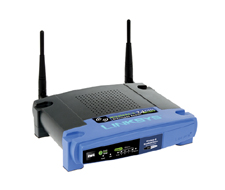Wi-fi, take #2

I first toyed with (802.11b) wi-fi a few years ago, when I bought a D-Link access point and a DWL-650+ wi-fi card for my ThinkPad running Linux. Memos to self from that experience:
- Don’t buy D-Link wi-fi stuff ever again. It really, really sucks. Shame, because I used to trust D-Link as a brand.
- Beware of little plus signs at the end of model numbers. I thought I was buying a DWL-650, which used a chipset for which there were proven, stable Linux drivers. But no, the little “plus” meant that it instead used a completely different chipset – the acx100 – which (at the time) had no production-quality Linux driver. (Side memo: don’t buy any wi-fi- cards with Texas Instruments chipsets if I need Linux support. Unless TI have woken up and smelled the coffee in the meantime?)
The results of this erroneous purchase were (a) days and days of messing about trying to get sodding alpha-quality drivers loaded into my Linux kernel; (b) when I finally got it working, speeds of around 200 kbytes/sec on a good day; (c) frequent disconnects, duplicate packets and lockups; and (d) the card overheating to the point where it hurt your hand as you pulled it out.
No, that was quite enough for me, thanks very much. All that, combined with the easily-crackable WEP encryption, meant that access point and card were quickly dumped in the garage.
So naturally, I approached the idea of wi-fi on my Mac with some trepidation. However, as I’m soon getting shunted into the bedroom to make room for little Isaac, and I really couldn’t be arsed to wire up the bedroom with Cat5, my hand has been somewhat forced.
I read about Apple’s various offerings – namely the AirPort Express and Extreme – but in the end decided to plump for an access point that not only has more features and oomph than the Airport Extreme (apart from 802.11n, which our iMacs don’t support anyway), but costs less than even the AirPort Express: the wonderful Linksys WRT54GL.
And what a gem it is. Great range – easily covers all the rooms in our apartment, so fine for both our iMacs. It’s a NAT router and firewall too, so I’ve finally managed to say goodbye to my bulky, noisy Linux tower PC in the corner of the office that was serving as my router and firewall. (I can’t tell you how nice a near-silent office is – just the barely-audible purr of the iMac, and the odd lorikeet squawking outside.) It features WPA2 with TKIP+AES encryption – about the strongest you can get at the time of writing.
Best of all though, it runs Linux (hence the ‘L’ in the name) and has a wide range of replacement third-party firmware available. This means that I don’t have to rely on Linksys to keep their firmware patched and current. In addition, third-party firmware such as DD-WRT actually adds features to the router, turning it, as many people say, from a $60 router into a $600 router. Get in!
I’m sticking with the default Linksys firmware for now, just to make sure all’s working OK (using third-party firmware invalidates the warranty, sadly), but soon I reckon I’ll stick Tomato on it. Sounds nice and easy to install, non-bloated, and with a whizzy AJAX Web UI showing you bandwidth usage graphs and all sorts of other cool stuff. Sounds perfect! 🙂
So I still have a Linux box in my office – just…
My only disappointment is with the speed. Somehow I naively expected 802.11g, which is advertised at 54 Mbits/sec, to be, well, at least close to 54 Mbits/sec. Think again, buddy:
- 54 Mbits/sec is the theoretical maximum; you’re lucky to get 25 Mbits/sec in day-to-day use.
- Add in the encryption and other protocol overheads, and you’re down to around 20 Mbits/s.
- Here’s the good one: if you transfer a file from one computer to another, only one computer can talk to the access point at any one time (hey, it’s radio!). So you’re actually looking at 10 Mbits/s in this (somewhat common) scenario.
The upshot is that I’m getting 1.3 Mbytes/sec when transferring files between the Macs. Hardly stellar. Still, at least it’s better than the D-Link’s pathetic 200 kbytes/sec, so I shouldn’t complain. I’m just not keen on having to wait over 2 hours to transfer 10 GB of files around (long story). Ah well – there’s always 802.11n next year…








